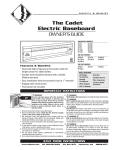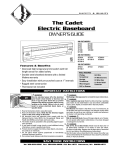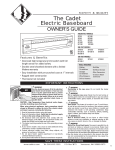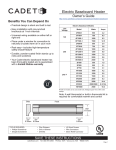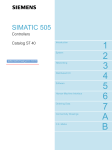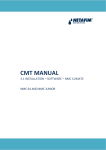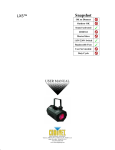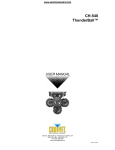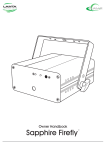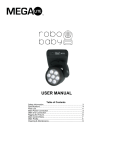Download The Cadet Electric Baseboard
Transcript
The Cadet Electric Baseboard OWNER’S GUIDE 240 Volt Models: 2F350 2F500 3F750 4F1000 5F1250 6F1500 8F2000 8F2500 10F2500 Features & Benefits • Oversized high temperature limit switch with full length sensor for added safety • Durable steel sheathed element with a lifetime warranty • Rugged steel construction 120 Volt Models: 2F500-1 3F750-1 4F1000-1 6F1500-1 208 Volt Models: 2F500-8 3F750-8 4F1000-8 5F1250-8 6F1500-8 8F2000-8 8F2500-8 Tools Required: Phillips Screwdriver Straight Screwdriver Wire Strippers Drill or Hammer Drill Bits 4 Wood Screws 3 Wire Nuts 1 Strain Relief Connector General Safety Information WARNING! Turn the electrical power off at the electrical panel board (circuit breaker or fuse box) and lock or tag the panel board door to prevent someone from turning on power while you are working on the heater. Failure to do so could result in serious electrical shock, burns, or possible death. 1. Read all information labels. Verify that the electrical supply wires are the same voltage as the heater. 2. All electrical work and materials must comply with the National Electric Code (NEC), the Occupational Safety and Health Act (OSHA), and all state and local codes. 3. The heater must be grounded to the grounding pigtail (copper wire) provided. 4. If you need to install a new circuit or need additional wiring information, consult a qualified electrician. 6. WARNING Overheating or fire may occur. DO NOT place the heater behind doors. 7. WARNING Fire or explosion may occur. DO NOT place heater in any area where combustible vapors, gases, liquids, or excessive lint or dust are present. 8. WARNING Risk of Electrical Shock. Turn off all power at the electrical panel board supplying power to the heater before wiring your heater. 9. WARNING Risk of Fire. Heater must be kept clear of all obstructions: maintain a 12” minimum clearance in front and above the heater with a 6” minimum on each side. Heaters must be kept clean of lint, dirt and debris. (See Maintenance Instructions) 5. Protect electrical supply from kinks, sharp objects, oil, grease, hot surfaces or chemicals. Keep For Future Reference TEL: 360-693-2505 Fax: 360-694-6939 P.O. Box 1675 Vancouver, WA 98668-1675 READ ALL INSTRUCTIONS AND SAFETY INFORMATION. Installation Instructions PLACEMENT: For best results, install the baseboard heater under a window, along an outside wall, or as close as possible to an outside door. THERMOSTAT: A thermostat is required. A Cadet by Honeywell wall thermostat is recommended for optimum WARNING! RISK OF ELECTRICAL SHOCK. TURN OFF ALL POWER AT THE ELECTRICAL PANEL BOARD SUPPLYING POWER TO THE HEATER BEFORE DOING ANY ELECTRICAL WIRING. WARNING! Risk of Fire. Heater must be kept clear of all obstructions: 12 inches in front and above; 6 inches on both sides minimum. performance, or you may prefer the convenience of a BTF-1 or 2 thermostat kit. STEP 1 AREA OF INSTALLATION STEP 3 BASEBOARD WIRING The seam at the junction of the wall and floor behind the heaters should be caulked to prevent dust from being drawn into the room. Heaters should be set flush against surface of the wall. When installing baseboard heaters, remove any obstructions between the back of the unit and the surface of the wall. Keep at least 12" minimum from objects hanging above (i.e., drapes). More than one baseboard heater can be wired in parallel on same circuit (Be sure to check national and local codes for safety requirements). STEP 2 MOUNTING HEATER TO WALL 1. Locate wall studs closest to supply wires and position heater. NOTE: Wire connection is possible from either right or left side of the baseboard heater. 2. Pre-drill mounting holes through the back of the baseboard case, spacing the holes the distance of at least two wall studs. VIEW A 3. Remove the wiring compartment cover. 4. Remove the slotted knockout closest to the supply wires and install a junction box connector. 1/ " 2 (13mm) A Figure 3. Disconnect (see Figure 3) splice "B" or "C" (NOT BOTH). DO NOT disconnect splice "A". Take one wire from each disconnected lead and connect to one supply or thermostat lead. Connect remaining wire from each heater lead and connect to remaining supply or thermostat lead. 240/208 Volt Baseboard Wiring PRE DRILL IN SHADED AREAS ONLY IMPORTANT! It is extremely important that you verify the electrical supply wires are the same voltage as the heater (i.e. 120 volt heater to 120 volt power supply and 240 volt heater to 240 volt power supply). If replacing an existing heater, check the labels of the old heater and replace using the same voltage. Hooking a 240 volt heater to a 120 volt power supply will drastically reduce the heater's output. Hooking a 120 volt heater to a 240 volt power supply will destroy the heater. C B Figure 1. 5. Pull supply wires through the connector leaving 6” wire leads for connection to the heater wires. 6. Mount the heater securely to the wall with nails or 3-wire hookup - 2 Hot Wires, 1 Ground (Be sure to check national and local codes for safety requirements). Left Side Wiring (See Figure 4) C B STUDS A Figure 4. Disconnect factory splice "A" or "B" (NOT BOTH). Connect each supply wire (or thermostat wires) to each lead wire (factory spliced wires). MOUNT SECURELY TO WALL Figure 2. screws going into at least two wall studs. NOTE: You do not need to remove the element, cover, or deflector to mount the heater. Baseboard heater may sit directly on any floor surface, including carpet. Do not allow carpet to block lower air intake located 1” from the bottom. 7. IMPORTANT: Connect the grounding lead to the grounding pigtail (copper wire) with a connector. 8. Connect the supply wires to the heater wires. Right Side Wiring (See Figure 4) Disconnect factory splice "C". Connect each supply wire (or thermostat wires) to each lead wire (factory spliced wires). WARNING! Risk of Electrical Shock. Connect grounding lead to grounding wire provided. Keep all foreign objects out of heater. Installation Instructions Thermostat Kit Wiring (Supply wire colors may vary. Reference to colors assumes general standards) RED WIRE BTF-1 (See Figure 5) Connect one supply black wire to the red thermostat wire. Connect black thermostat wire to one heater wire. Be sure the other supply wire is connected directly to heater wire. Connect ground. 2 RED WIRES BTF-1 BTF-2 2 BLACK WIRES Figure 6. BLACK WIRE Figure 5. BTF-2 (See Figure 6) Connect one each of the supply wires to one each of the red thermostat wires. Connect black thermostat wires to remaining (factory spliced) heater wires (see Figure 4 on previous page). 120 Volt Baseboard Wiring 3-wire hookup - 1 Hot Wire, 1 Neutral, 1 Ground (Be sure to check national and local codes for safety requirements) C B Left Side Wiring (See Figure 7) Disconnect factory splice "A" or "B" (NOT BOTH). Connect each supply wire (or thermostat wires) to each lead wire (factory spliced wires). Right Side Wiring (See Figure 7) Disconnect factory splice "C". Connect each supply wire (or thermostat wires) to each lead wire (factory spliced wires). A Figure 7. WARNING! Risk of Fire. Heaters must be kept clean of lint, dirt and debris. Failure to follow warnings may cause heater to eject sparks, ignite materials, or cause electrical shock. RED WIRE Thermostat Kit Wiring (Supply wire colors may vary. Our reference to colors assumes general standards) BTF-1 (See Figure 8) Connect supply black wire to the red thermostat wire. Connect black thermostat wire to one heater wire. Check to be sure the other supply wire is connected directly to heater wire. Connect ground. BTF-1 BLACK WIRE Figure 8. Operation & Maintenance How To Operate Your Heater Maintenance 1. Switch the power on at the electrical panel board. PLEASE NOTE: Upon initial start-up, the heater may emit a burning odor. This is not dangerous, and is due to a protective lubricant used during the manufacturing process. 2. Turn the thermostat fully clockwise. 3. When the room reaches your comfort level, turn the thermostat knob counterclockwise until a clicking sound is heard (if using a digital thermostat, set at desired room temperature). The baseboard will automatically cycle around this preset temperature. Cadet electric baseboards are virtually maintenancefree. However, a certain amount of lint and dust will accumulate inside the unit and should be periodically cleaned: 1. Turn the electrical power off at the electrical panel board (circuit breaker or fuse box) and lock or tag the panel board door to prevent someone from turning on power while you are working on the heater. Failure to do so could result in serious electrical shock, burns, or possible death. 2. Remove front panel. 3. Vacuum inside the unit, being careful not to damage the aluminum fins on the heat exchanger. WARNING! Turn the electrical power off at the electrical panel board (circuit breaker or fuse box) and lock or tag the panel board door to prevent someone from turning on power while you are working on the heater. Failure to do so could result in serious electrical shock, burns, or possible death. Troubleshooting Chart CONSULT LOCAL ELECTRICAL CODES TO DETERMINE WHAT WORK MUST BE PERFORMED BY QUALIFIED ELECTRICAL SERVICE PERSONNEL Symptom Snapping noise Problem Solution 1. Unit may have a loose end plate. 1. Loosen end plate screws 1/4 turn after allowing heater to warm, move end plate back and forth, then tighten 2. Loosen heater from wall by turning mounting screws a 1/4 turn 2. Heater may not be mounted properly Heater not working 1. Heater does not have proper voltage to function correctly 1. Check voltage at the heater between supply wires and make sure it matches required heater voltage 2. Tighten any loose wire connections 3. Circuit breaker positioned incorrectly - relocate breaker 4. Limit defective - replace limit Heater will not shut off 1. Heat loss from room is greater than heater capacity 2. Defective thermostat 1. Close doors and windows. Provide additional insulation, install a higher-wattage heater or multiple heaters if necessary 2. Adjust thermostat to its lowest setting. If heater continues to run (allow two minutes for the thermostat to respond), replace thermostat 3. Refer to thermostat documentation and correct wiring 3. Thermostat wired incorrectly to heater Black streaks (sooting) depositing on baseboard, walls, and drapes 1. Excessive hydrocarbons present in home environment* 2. Not enough fresh air flowing through baseboard 3. Streaking being allowed to build up on room surfaces 1. Remove/reduce use of items emitting hydrocarbons. (Common sources: insect foggers, aerosol sprays, carpet cleaning chemicals, candles, plants, dust, cigarette smoke and fireplaces) 2. Increase amount of fresh air available in room. Do not use heater during any chemical usage (insect fogging, carpet cleaning, etc.) and allow for outside air exchange before re-use of heater(s) 3. More frequent cleaning of streaking to reduce amount of build-up * Black soot and residue is formed by the combustion of hydrocarbons. Existing hydrocarbons in environment pass through heater element and scorch, exit the heater and deposit on walls and room surfaces. Note: The heater itself does not produce/release any hydrocarbons. Warranty Warranty Information Maintenance: For safer operation and to prolong the life of the heater, it is necessary to follow the maintenance instructions included with each heater. Failure to properly maintain the heater will result in the warranty being voided. All warranties offered to original consumer only. Warranty instructions included with each heater. All Cadet Products LIMITED ONE-YEAR WARRANTY: Cadet Manufacturing Co. will repair or replace any Cadet product, including thermostats, found to be defective or malfunctioning from first date of purchase through the first year. Extended Product Warranties Baseboard Element (F) LIMITED LIFETIME WARRANTY: Cadet Manufacturing Co. will repair or replace any Cadet baseboard (F) element found to be defective or malfunctioning from first date of purchase throughout lifetime. THESE WARRANTIES DO NOT APPLY: 1. To conditions resulting from improper installation or incorrect supply voltage; 2. To conditions resulting from improper maintenance, misuse, abuse, accident, or alteration; 3. To service calls or labor involved in replacing defective part(s); 4. If the date of manufacture cannot be determined; 5. To freight damaged products. CADET SHALL NOT BE LIABLE FOR DAMAGES SUCH AS PROPERTY DAMAGE AND/OR INCIDENTAL EXPENSES RESULTING FROM BREACH OF THESE WRITTEN WARRANTIES OR ANY IMPLIED WARRANTY. These warranties give you specific legal rights, and you may also have other rights which vary from state to state. Cadet neither assumes, nor authorizes anyone to assume for it, any other obligation or liability in connection with these electric heaters or any part of such heaters. If the product should become defective during the warranty period, contact Cadet Manufacturing Co. at 360.693.2505 for instructions on how to have the repair or replacement processed. Products returned without authorization will be refused.




